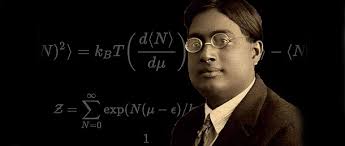Satyendra Nath Bose, FRS was an Indian mathematician and physicist specializing in theoretical physics. He is best known for his work on quantum mechanics in the early 1920s, collaboration with Albert Einstein in developing the foundation for Bose-Einstein statistics and the theory of the Bose-Einstein condensate.
Bose was born on 1 January 1894 in Calcutta (now Kolkata). His father, Surendranath Bose, worked in the Engineering Department of the East Indian Railway Company. Bose did his early schooling from New Indian School and his last years of schooling from Hindu School. He passed his matriculation in 1909.
You don’t know who he was? Half the particles in the universe obey him!
[Reply by a physics professor when a student asked who Bose was.]
He next joined the intermediate science course at the Presidency College, Calcutta. Bose chose mixed (applied) mathematics for his BSc and passed the examinations standing first in 1913.
He then joined Sir Ashutosh Mukherjee’s newly formed Science College where he again stood first in the MSc mixed mathematics exam in 1915. His marks in the MSc examination created a new record in the University of Calcutta, which is yet to be surpassed.
After completing his MSc, Bose joined the Science college, Calcutta University as a research scholar in 1916 and started his studies in the Theory of Relativity. It was an exciting era in the history of scientific progress. Quantum theory had just appeared on the horizon and important results had started pouring in.
As a polyglot, Bose was well versed in several languages such as Bengali, English, French, German, and Sanskrit as well.
From 1916 to 1921, he was a lecturer in the physics department of the Rajabazar Science College under the University of Calcutta. In 1921, he joined as Reader of the Department of Physics of the recently founded University of Dhaka.
At the University of Dhaka, Bose wrote a paper deriving Planck’s quantum radiation law without any reference to classical physics by using a novel way of counting states with identical particles. This paper was very important in creating an important field of quantum statistics. Though not accepted at once for publication, Bose sent the article directly to Albert Einstein in Germany. Einstein, recognizing the importance of the paper, translated it into German himself and submitted it on Bose’s behalf to the prestigious German journal Zeitschrift für Physik.
Thus Bose got a chance to work in European laboratories with Einstein, Marie Curie, and de Broglie for two years between 1924 to 1926.
During a lecture at the University of Dhaka, Bose for the first time took the position that the Maxwell–Boltzmann distribution would not be true for microscopic particles, where fluctuations due to Heisenberg’s uncertainty principle will be significant. Thus he stressed the probability of finding particles in the phase space, each state having volume h3, and discarding the distinct position and momentum of the particles.
Bose adapted this lecture into a short article called “Planck’s Law and the Hypothesis of Light Quanta” and sent it to Albert Einstein. Einstein agreed with him, translated Bose’s paper “Planck’s Law and Hypothesis of Light Quanta” into German, and had it published in Zeitschrift für Physik under Bose’s name, in 1924.
These papers led to the creation of Bose-Einstein Statistics. Using Bose’s interpretation, Einstein published a paper in which he predicted the existence of Bose-einstein condensate.
When Bose came back from Europe to Dhaka, he did not have a doctorate, and thus he couldn’t get a professor position which he applied for but he was recommended by Einstein. So, he was then made Head of the Department of Physics at Dhaka University. He continued guiding and teaching at Dhaka University.
Bose also published an equation for real gases with Meghnad Saha.
After partition, Bose came back to Calcutta and taught there until 1956. He served as the Vice-Chancellor of Visva-Bharati University in Santiniketan.
Bose also worked in Nuclear Physics and Organic Chemistry. In the subsequent years, he worked in applied research like extracting Helium in hot springs.
For his contributions, Bose was conferred with several honors in India. He was awarded Padma Vibhushan in 1954. He was appointed as National Professor, the highest honor for a scholar in India. He held that position for 15 years. In 1986, the S.N. Bose National Centre for Basic Sciences was established in his honor. He held several high-level positions for different institutes in the country. He was nominated as a member of Rajya Sabha.
Coming to international honors, although seven Nobel Prizes were awarded for research related to Bose’s concepts, he never received Nobel Prize.
A class of elementary particles were named Bosons in his honor. He was also a Fellow of the Royal Society.
Though he faced a lot of rejections for publishing his work, he didn’t loose hope and got his work published. His biggest achievement is that his name will be in daily science discussions for ever in the form of Bosons, Bose-Einstein Condensate, Bose-Einstein statistics etc.
Salute to this Indian genius…

